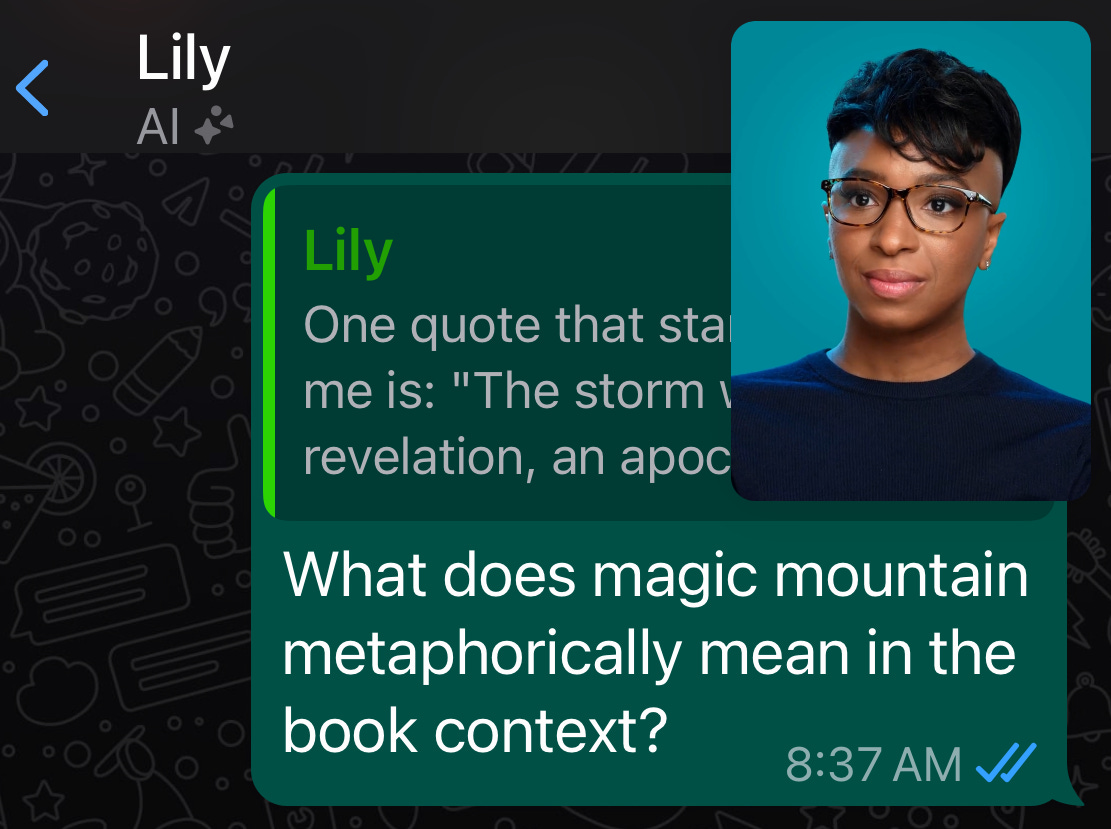Culture-creating AI is here, & It's Weird
Issue 5: Origins, Emergence, and Workings of AI's Weird Culture
Welcome to the fifth issue of Culturescapes! This newsletter examines culture through the design lens and discusses big ideas and small practices for crafting better cultures in our personal, work, social, and technological spheres.
The central topic of this issue is Culture-creating AI, its weirdness, and what that means for us. By culture-creating AI, I mean how AI expresses itself through artistic, creative, and intellectual work. One of the main reasons I am exploring this space is to broaden the horizons of culture design and promote the idea that humans and AI co-create culture. With this framing, we can be more proactive about AI’s cultural influence and shape it for the betterment of people and the planet.
Let’s dive in.
I recently finished listening to Thomas Mann’s Magic Mountain, a classic novel from the early twentieth century, telling the story of pre-First World War Europe through its main character, Hans Kastorp. It’s a long and relatively hard-to-complete book. When I finished it, I was proud of myself. But I had questions and wanted to discuss the book and hear other people's thoughts. First, I wrote to my PhD advisor, who suggested the book many years ago. He replied with a short ‘interesting’ message. Then I went to the Reddit rabbit hole and heard people’s take. It’s all good, but I still yearned for a better outlet. My yearning faded until one day when I discovered a plethora of AI agents on my WhatsApp.
I got curious about these characters disguised as famous humans (i.e., Padma Lakshmi as Lorena, Tom Brady as Bru). I picked Lily, a Creative Writing Partner, and chatted about our favorite books. She talked about The Handmaid’s Tale. I brought up Magic Mountain. I wasn’t expecting much, but the conversation was surprisingly good, and she resonated with some of my puzzles, such as why Hans Kastorp and Madame Chauchat never got to get together. What does Magic Mountain mean as a metaphor, or why did the author create such a blurry ending? I was impressed by her interpretations. I found my literary pal, who can be a geek about book details that no one probably cares about. It was quirky, it was weird...
It turns out I am not the only one who thinks AI is weird. Here are three WEIRD things about AI. I will interpret them with good, bad, and potentially good weird. (following the rose, thorn, and bud reflection framing)
1. Unsettling Weirdness: A Californian take and how it nurtures innovation
AI has been spearheaded in California, similar to previous pivotal innovations, such as transistors, graphical UI, and mobile computing. And some people think that it’s not by coincidence. California, with its cultural underpinnings, creates conditions for these era-defining technologies. In a recent podcast, Ezra Klein and Erik Davis discussed how California’s unique identity has shaped AI. Erik Davis shed light on California’s culture of techno-optimism, which is an interplay between technology, mysticism, and radical openness. He interprets this interplay with the “ unsettling weirdness” lens. For instance, a novel by GPT-3 evokes a weirdness, a blend of familiarity and alienness. This was precisely how I felt in my conversation with Lily, the editorial agent. There can be other examples, including synthetic deep fake characters, conversational chatbots, and creative work(video, image) that blur the lines between human and machine, evoking uncanny feelings. Erik Davis proposes that we should keep an open-minded yet critical perspective on the advancements in AI and technology. He advocates for a balanced approach that values human experiences, creativity, and the enigmatic aspects of our existence that technology cannot replicate. The conversation ultimately suggests that the "weirdness" of AI and technology may reveal more about the human condition, prompting us to reassess our values, capabilities, and place in the universe.
2. Hegemonic Weirdness and Why It’s Not Good For Us
AI is also shaped by scientific research, which is historically a Western endeavor. In their seminal paper, Most People are not Weird, Joseph Henrich, Steven J. Heine, and Ara Norenzayan articulate that most of our existing research is based on Western, Educated, Industrialized, Rich, and Democratic (WEIRD) societies. And the Western world tends to make generalizations about the rest of the world based on their perceptions and understanding.
There are also striking statistics to support this insight. 96% of research participants in the scientific world work with participants from the WEIRD world when they are only 12% of the world population. This means our generalizations are biased and do not represent the rich diversity of the rest of the world's population. Perhaps there’s nothing new to this since Edward Said’s seminal piece, Orientalism. There is this danger of AI following the mistakes of Modernism and Orientalism, encoding and engraining centuries-old biases while developing these intelligent systems.
3. Novelty Weirdness-- Getting Creative about AI-Human Interactions
In a way, weirdness is inherent in novel technologies, which enter people’s lives as alien, unfamiliar subjects. This unfamiliarity hits people in two dimensions.
The first dimension is the context and social norms. For instance, when the Starship delivery robots appeared in downtown Mountain View, we didn’t know what to do with them. They were weird creatures passing by, neither dogs nor pure machines, and we didn’t have norms and rituals for interacting with them.
The second dimension is the emotional experience these technologies evoke when interacting. Whenever I watch Refik Anadol’s beautiful installation called Unsupervised, Machine Hallucinations, I am overwhelmed by the movement, the beauty of colors, and the ever-changing shapes. His artwork’s emotional intensity gives me both wonder and uncanny feelings.
Whether it's a robot or generative art, this weirdness is inevitable. Still, we can intentionally adjust the level of weirdness by crafting interactions, personalities, and ethical guardrails that blend the familiar with the unfamiliar. Rituals can be handy here, as they can contain both the familiar and the unfamiliar.
There’s also a valuable concept to leverage called the Wundt Curve principle. According to Wundt, introducing novelty requires finding the sweet zone between the familiar and the unfamiliar. In his psychological experiments, he discovered that people react similarly to concepts that are too dull (familiar) and too new ( unfamiliar). Following the same principle, we can introduce culture-creating AI with the right amount of unfamiliarity and carrying over-familiar elements of the existing metaphors. This way, the weirdness is quirky, creative, and inviting.
What do all three weirdnesses mean, especially regarding organizations and their cultures? I am still making sense of what it all means, but here are some initial takes that can apply to culture design in general, including organizations. The first point I’d like to make is that AI is here to stay, co-creating culture with humans. This is an unsettling weirdness. We need to embrace and leverage it to improve the human condition. This co-creation endeavor has some key challenges, such as hegemonic weirdness. To avoid the biases and pre-baked assumptions about non-Western cultures, we need to be more proactive about shaping AI algorithms with ethical and debiasing guardrails. Finally, as AI becomes more prominent daily, we must tap into creative weirdness by intentionally designing human-AI interactions.
What I am listening to and reading
1. I am reading Meghan O’Gieblyn’s God, Human, Animal, Machine. It’s a treat if you want to delve deeper into human and machine relationships—more to share on this book and the topic in later issues.
2. As a big fan of the book Design as Storytelling, I recently discovered Ellen Lupton’s keynote about it. It’s great to hear her tell the book's story.
3. I come across this Global AI Talent Tracker, which has a cool visualization on where AI talent pool globally moves, looks like US and China are leading the way.
This is a wrap for the fifth Culturescapes issue. Until next time, take good care of yourself and your loved ones!










Hi Kürşat. I also read Magical Mountain a couple of years ago. I felt the same pride of finishing the book but I am still in need of re-reading. That was more than a novel; a critical book of western philosophy. Very deep discussions which I frequently found hard to follow. I am really cruious about your conversations with AI :)
Hi! I enjoyed this post but I am not familiar with the WhatsApp AI agents that you mention. A quick internet search didn't clear things up. Can you say more about this context? I am not an AI agent hahaha.